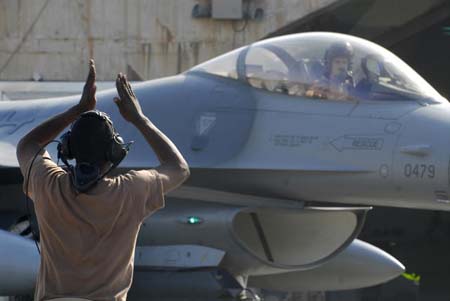T he Air Force is beginning to be more vocal in articulating its need for a big shot in the arm to modernize its already “geriatric” aircraft fleet. More and more senior service officials are coming out on the record and citing the need for an extra $20 billion on average annually for the next 20 years, saying that, without such infusions, the air dominance that the US has enjoyed for decades will erode if not disappear altogether. “What we’ve done is put the requirement on the table that says, ‘If we’re going to do the missions you’re going to ask us to do, it will require this kind of investment,” Maj. Gen. Paul Selva, director of strategic planning on the Air Staff, told the Associated Press in a story filed Feb. 19. “Failing that, we take what is already a geriatric Air Force … and we drive it for another 20 years into an area of uncertainty.” The Air Force has established that, to carry out the national military strategy and protect the homeland, its needs 86 fully modern combat wings, which it refers to collectively as the Required Force. Since existing and projected budget toplines will not get it to that level of fighters, bombers, tankers, rescue helicopters, manned and unmanned intelligence platforms, and satellites, the $20 billion increase is necessary, the senior officials are saying. We expect to hear this consistent message at this week’s AFA Air Warfare Symposium in Orlando, during the Congressional hearings on the service’s Fiscal 2009 request, and throughout the course of the year as the Fiscal 2010 program objective memorandum takes shape and USAF, like the other services, prepares for a new Administration. But are things really as bad as the Air Force is saying? Just ask Air Force Special Operations Command about its MC-130s covert insertion/extraction airplanes and AC-130 gunships. “We are literally flying the wings off these two airplanes,” Brig. Gen. Brad Heithold, who overseas the command’s plans, programs, requirements and assessments, told AP.
he Air Force is beginning to be more vocal in articulating its need for a big shot in the arm to modernize its already “geriatric” aircraft fleet. More and more senior service officials are coming out on the record and citing the need for an extra $20 billion on average annually for the next 20 years, saying that, without such infusions, the air dominance that the US has enjoyed for decades will erode if not disappear altogether. “What we’ve done is put the requirement on the table that says, ‘If we’re going to do the missions you’re going to ask us to do, it will require this kind of investment,” Maj. Gen. Paul Selva, director of strategic planning on the Air Staff, told the Associated Press in a story filed Feb. 19. “Failing that, we take what is already a geriatric Air Force … and we drive it for another 20 years into an area of uncertainty.” The Air Force has established that, to carry out the national military strategy and protect the homeland, its needs 86 fully modern combat wings, which it refers to collectively as the Required Force. Since existing and projected budget toplines will not get it to that level of fighters, bombers, tankers, rescue helicopters, manned and unmanned intelligence platforms, and satellites, the $20 billion increase is necessary, the senior officials are saying. We expect to hear this consistent message at this week’s AFA Air Warfare Symposium in Orlando, during the Congressional hearings on the service’s Fiscal 2009 request, and throughout the course of the year as the Fiscal 2010 program objective memorandum takes shape and USAF, like the other services, prepares for a new Administration. But are things really as bad as the Air Force is saying? Just ask Air Force Special Operations Command about its MC-130s covert insertion/extraction airplanes and AC-130 gunships. “We are literally flying the wings off these two airplanes,” Brig. Gen. Brad Heithold, who overseas the command’s plans, programs, requirements and assessments, told AP.
The rate of building B-21 bombers would speed up if the fiscal 2026 defense budget passes. But it remains unclear how much capacity would be added, and whether the Air Force would simply build the bombers faster, or buy more.